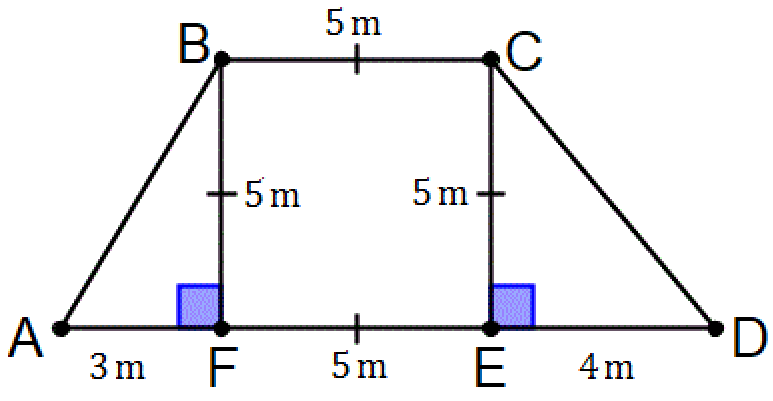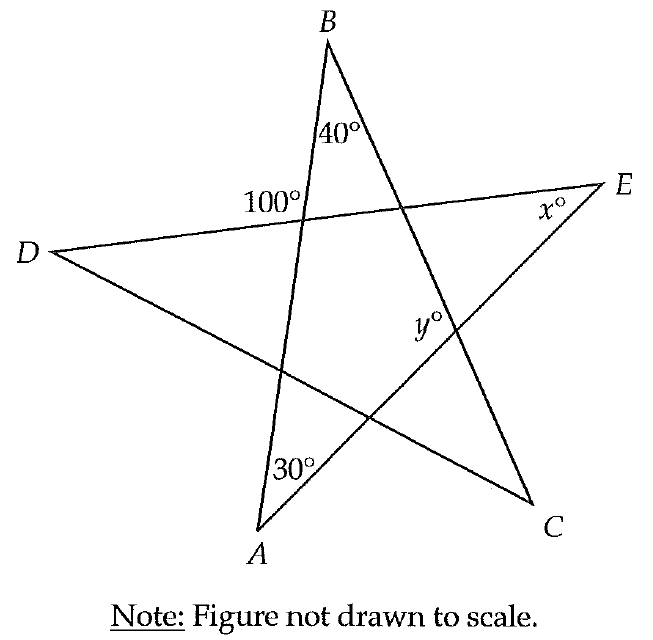AREA OF TRAPEZIUM
Definition of Trapezium :
The definition of trapezium is entirely different in both US and UK.
- In US, a quadrilateral which is having no parallel sides is called trapezium.
- But in UK, a quadrilateral which is having one pair of parallel sides is called trapezium.
Definition of Trapezoid :
- In UK, a quadrilateral which is having no parallel sides is called trapezoid.
- But in US, a quadrilateral which is having one pair of parallel sides is called trapezoid.

In the trapezium / trapezoid above, 'a' and 'b' are the lengths of the parallel sides and 'h' is the height.
Formula to Find Area of Trapezium / Trapezoid :
A = (1/2)(a + b)h
Examples
Example 1 :
Find the area of the trapezium ABCD shown below.

Solution :
Area of trapezium = (1/2)(a + b)h
Substitute a = 5, b = 12 and h = 4.
= (1/2)(5 + 12)4
= (1/2)(17)4
= 34 cm2
Example 2 :
In a trapezium the measurement of one parallel side two more than the other parallel side and the height is 4 cm. The area of the trapezium is 64 cm2. Find the lengths of the two parallel sides.
Solution :
Let 'a' and 'b' be the two parallel sides.
One parallel side is two more than the other parallel side.
Then,
a = b + 2
Area of the trapezium = 64 cm2
(1/2)(a + b)h = 64
Substitute h = 4 and a = b + 2.
(1/2)(b + 2 + a)4 = 64
(2b + 2)2 = 64
Divide each side by 2.
2b + 2 = 32
Subtract 2 from each side.
2b = 30
Divide each side by 2.
b = 15
Then,
a = b + 2
a = 15 + 2
a = 17
So, the lengths of the two parallel sides are 15 cm and 17 cm.
Example 3 :
The shape of the top surface of a table is a trapezium. Find its area, if its parallel sides are 1 m and 1.2 m and perpendicular distance between 0.8 m.

Solution :
Area of a the top of surface of the table (trapezium) is
= (1/2)(a + b)h
= (1/2)(1.2 + 1)0.8
= (1/2) (2.2)0.8
= 1.1 (0.8)
= 8.8 m2
Example 4 :
The wall is in the shape as shown below has to be painted. If one can of paint covers 0.5 m2, how many cans of paint will be needed, if only one coat of paint is applied ?

Solution :
In the figure shown above, the perpendicular distance between the two sides BC and AB at any point is same, which is 5 cm.
Then, the sides BC and AD are parallel.
In the quadrilateral above, because the two sides BC and AD are parallel, ABCD is a trapezium.
Let 'a' and 'b' be the lengths of two parallel sides and.
a = BC = 5cm
b = AD = AF + FE + ED = 3 + 5 + 4 = 12 cm
Height (h) = 5 cm
Area of the trapezium ABCD is
= (1/2)(a + b)h
Substitute a = 5, b = 12 and h = 5.
= (1/2)(5 + 12)5
= 42.5 m2
One can of paint covers 0.5 m2.
Number of cans of paint required 42.5 m2 is
= 42.5 / 0.5
= 425 / 5
= 85
So, 85 cans of paint required to cover the above wall.
Kindly mail your feedback to v4formath@gmail.com
We always appreciate your feedback.
©All rights reserved. onlinemath4all.com
Recent Articles
-
Digital SAT Math Problems and Solutions (Part - 134)
Apr 02, 25 12:40 AM
Digital SAT Math Problems and Solutions (Part - 134) -
SAT Math Resources (Videos, Concepts, Worksheets and More)
Apr 02, 25 12:35 AM
SAT Math Resources (Videos, Concepts, Worksheets and More) -
Digital SAT Math Problems and Solutions (Part 135)
Apr 02, 25 12:32 AM
Digital SAT Math Problems and Solutions (Part 135)

